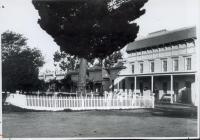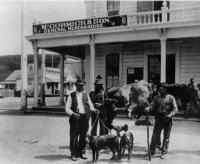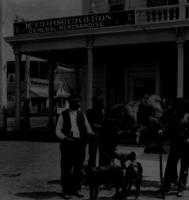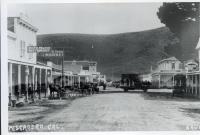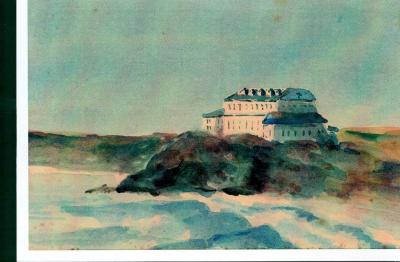The messages remind folks that there’s going to be a “town photo”, giving the time and place.On Stage Road. I love it!

From Pebble Beach Pebble to Pebble Beach Pendant

Mrs. Caroline Dias, just the sweetest lady who lived in Pescadero (she passed away some time ago), grew up in the village, married and lived across the street from the library where she worked. Like many Pebble Beach-goers before her, she found a favorite pebble, had it polished and turned into a pretty pendant that hung from this gold chain.
The aunt of Ron Duarte, Mrs. Dias became one of the sources for my book, “The Coburn Mystery”. She was familiar with the characters in the 20 th century part of the book.
Oops–almost forgot, you can’t pick the pebbles anymore.
Kid Zug in Pescadero: Part IV
In 1919 a battered and bruised Frank Goularte, the 40-year-old son of the Pescadero blacksmith, was anxious to talk to the authorities about the beating he had received from Kid Zug– the recent winner of the highly anticipated outdoor bout with “Happy” Frey, son of the village bartender and constable.
“I was on my way to a dance,” Goularte began. “Before going there I stopped at San Gregorio to get a shave and when I left the shop,” the blacksmith’s son said he was suddenly, violently assaulted by Kid Zug. He intended to bring charges against the pugilist.
When he appeared before the Justice of the Peace in Redwood City, a wounded and angry Frank Goularte charged Zug with battery. A trial date was set and the Kid appeared before a jury in November 1919.
The evidence presented at trial definitely proved that the attack had occurred–but the jury believed Zug’s version of events, citing that his actions were defensible and justifiable. They were convinced that Goularte had directed slurs at Zug and made a move that looked as if he were about to draw for a gun. Kid Zug was acquitted of all the charges.
Insiders guessed at the truth: Frank Goularte was an important witness in the murder investigation involving the death of Sarah Coburn, a wealthy Pescadero widow. He lived across the street from Sarah, and on the night of her murder, had observed the comings and goings of possible suspects. His testimony could prove to be devastating to Zug’s employer–believed to have played a pivotal role in the slaying.
Some folks in the know believed the beating Kid Zug administered to the blacksmith’s son was a clear message to Goularte to keep his mouth shut.
Perhaps Zug’s influential employer was responsible for suppressing the murder invesstigation and having the whole matter dumped into a permanent cold case file.
By 1920 few people were even talking about the murder case.
Kid Zug quietly packed up his few belongings and left the Swanton House and Pescadero forever.
The END
Kid Zug: Part III
Itâs true that Kid Zugâs boxing skills were a shadow of what they had been 35 years earlierâand that his opponent, âHappyâ? Frey had a big-mouthâbut for the boys in the village of Pescadero, a boxing match with world champ Abe Attell could not have brought them more excitement.
Details of the 1918 event remain sketchy but as the day of the fight drew near people came from all around.
When the moment finally arrived, the combatants entered the ring and the crowd was breathless. Kid Zug was stone-faced and silent. Happy Frey was clearly nervous and ringsiders wondered if either fighter was sober.
The referee spoke to them for a moment and signaled for the bell to start the fight.
Both boxers were tentative. Zug kept his hands high to protect his scarred face. Happyâs inexperience quickly presented an opening for the Kid who launched a solid right cross which staggered Happy and knocked out several of his teeth.
The fight was over.
Although the ending was unexpected, the stunned crowd seemed satisified with the outcomeâespecially those that had bet on the Kid.
Zugâs ability to strike so swiftly at his advanced age amazed everyone.
Pescaderans would never forget the short boxing match on San Gregorio Street.
But a year later, in the summer of 1919, a brutal murder occurred in Pescadero. It ws a seamy case involving the slaying of a wealthy, elderly widowâand all bets were that the people Zug worked for had something to do with it.
Around this time it was report4d that Zug fell ill with pneumonia. In Pescadero many villagers were coming down with the dreaded âSpanishâ? flu, the post-World War I influenza pandemic that took the lives of millions worldwide.
Some insiders suspected that Zugâs illness might have presented a perfect cover to get him out of town during the murder investigation.
For weeks the Kid was confined to a hospital room in San Mateo. As soon as he recovered, to everyoneâs astonishment, Zug was back on the wooden sidewalks of Pescadero, intimidating and menacing.
Not long after returning to town, Zug faced real trouble. According to official court testimony and leaks to the local press, he was a major principle in an assault case. On a late Saturday night in September 1919 the lightweight pugilist was accused of badly beating 40-year-old Frank Goularte, the 190-pound son of the Pescadero blacksmith. In the melee, Goularte suffered two black eyes, a fractured nose and bruises on his face and head.
While he was being patched up, authorities questioned Frank Goularte.
â¦.To be continued
Kid Zug: Part II
While many Pescaderans must have been intimidated by Kid Zugâs battered-looking face–âHappyâ? Frey, whose constable father Herman owned the Elkhorn Saloon on San Gregorio Street– took one look at Zug and boasted to one and all that he could knock him out flat.
Happyâs exuberance could be attributed to his youth, or was it the alcohol content of his favorite beverages?
Unfortunately, his boxing experience was limited to fist fights with the local town toughs. Nevertheless, Happy remained confident, knowing that Kid Zug was probably close to 60 years old.
Happyâs boasting soon reached the Kidâs ears at the Swanton House where Zug was rooming. In its glory days the Swanton had been the centerpiece of the resort town, but by 1918 it had become a crummy, rundown hotel.
Kid Zug was not about to leave Happyâs arrogant claims unchallenged. The confrontation was unavailable and word of their contest quickly spread about town.
The Kid may have seemed too old to fight, but his credentials as a boxer were much discussed. He was a 135-pound lightweight, a former sailor turned professional pugilist. His early skills were honed in the violent back rooms of saloons on the East Coast. His face revealed the scars of many tough battlesâin and out of the ringâand it could very well be that the Pescaderans had never seen a professional boxer before.
Those included to support Happy Frey felt that the Kid was long past his prime, down on his luck, in bad shape, and that liquor had gotten the best of him. They pointed out his slurred speech, the result of repeated beatings. They said he was a âlittle wacky from getting hit in the head.â? Yet Zugâs ability to intimidate was not impaired. With merely a glance he could wither nearly anybody he encountered and that was exactly why he had been hired.
Happy Frey was a pure Pescaderan. His father, Herman, was the local constable as well as the owner of the Elkhorn Saloon. His mother, Lizzie McCormick Frey, was the lady bartender with the trademark deep voice.
And her father, John McCormick, had at one time owned the renowned Pescadero House, Swanton House and the townâs general store.
To the folks who were running Pescadero, the fight was an event sent from heaven. Booze would flow and cash registers rings. The customers would bet on the fight and have dollars in their pocket.
Arrangements were quickly drawn up, and construction of the outdoor boxing ring began at the southern end of what was then called San Gregorio Street, near the townâs landmark flagpole.
To be continued….
The Man Who Called Himself “Kid Zug”: Part I
(Note: The true story of âKid Zugâ? was stitched together, using old newspapers to pick out a description here, another thereâuntil I gathered enough pieces for a word picture).
âKid Zugâ?: Part I
In 1918 workmen hurriedly erected an outdoor prize fight ring on the saloon-fronted San Gregorio Street in Pescaderoâand everybody buzzed about the upcoming boxing match between the newly arrived âKid Zugâ? and his local opponent, âHappyâ? Frey.
In California boxing was illegalâso was gamblingâand had it been any place other than Pescadero, the authorities would have clamped down. But this was Pescaderoâwest of the magnificent redwood forest on San Mateo Countyâs remote South Coastâand outsiders didnât care (or know) what was going on there.
The village of Pescadero was about 70 years old in 1918âbut it was local lore that you could tell what was fashionable by the contents of the cargo salvaged from the last shipwreck.
In the 1890s, for example, horse-and-buggy tourists were surprised to see every single house in town with a fresh coat of white paint. They learned that the Pescaderans had been the beneficiaries of a bonanza in the form of tons of paint salvaged from the shipwrecked vessel Colombia.
A quarter century later it was more likely that the villagers would be salvaging cases of illegal liquor from the unlucky bootlegging fishing trawlers that had crashed into the dark rocky reefs on moonless nights.
Newcomers to the Coastside village, particularly those with the ârightâ? connections, quickly discovered that slot machines and card games were found in a two=story house at a curve on the lonely road leading east into the redwoods.
Even more fascinating were the rumors that certain county officials were regularly in attendance, playing the one-armed bandits.
Among the intriguing newcomers was a ruddy, scar-faced ex=pugilist who called himself âKid Zugâ?.
He was seen paling around with the owner of the gambling joint. Although âthe Kidâ? explained his presence in town by saying he was a house painter, he was never seen holding a paintbrush. He was much more often seen tipping back a glass of beer at one of the four saloonsâand he never ceased menacing those around them.
It didnât take long for the locals to learn the truth: Kid Zug was really in town to act as a strong-arm enforcer.
To be continuedâ¦.
Thank you, Richard Schellen
Years ago, when I first started searching through old newspapers for stories on the Coastside, a helpful librarian steered me to the “amazing” Richard Schellen Collection.
I cannot praise Richard Schellen enough for the work that he left anyone interested in local history, or a specific event, such as when a building was built or burned.
Mr. Richard Schellen was once Redwood City’s head librarian, but I think of him as a librarian’s librarian.
This wonderful man organized and typed up thousands of stories– either in their entirety or the first few sentences, (you could always find the longer original) –and he organized these stories by date and town, in some cases going back to the mid-19th century and earlier.
In the Schellen Collection you can find political stories, business stories—murder stories….Perfectly organized by town and date. It’s a great resource.
I wish I could have met Richard Schellen to thank him personally. He gave us writers and historians and the folks of San Mateo County so much.
The Schellen Collection can be viewed at the main Redwood City library as well as the San Mateo County History Museum, located in Redwood City’s old courthouse.
Here’s hoping you enjoy the collection as much as I did.
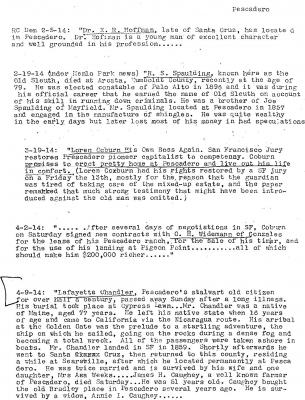 A sample page from the Richard Schellen Collection–this sheet lists a few stories about Pescadero. Click to enlarge.
A sample page from the Richard Schellen Collection–this sheet lists a few stories about Pescadero. Click to enlarge.
Loren Coburn’s Folly: Pescadero’s Pebble Beach Hotel
In the 1890s Loren Coburn, the most hated man in Pescadero, built the Pebble Beach Hotel overlooking the popular and locally sentimental pebble-covered beach south of the tiny village. From what we know guests never stayed overnight– except for the watchman who was there to protect the new hotel from vandalism. (Among modern conveniences the Pebble Beach Hotel offered the luxury of hot and cold water). Business associates of Coburns (perhaps anxious to take advantage of the illiterate but wealthy man) sometimes held private parties at the hotel.
Local artist Galen Wolf wandered up and down the Coastside using his box of watercolors to preserve the past for us. Here, before it was torn down to make way for Highway 1, is Wolf’s picture of Loren Coburn’s Folly: the Pebble Beach Hotel at Pescadero where the rooms remained empty and, perhaps haunted, for decades.
In 1992 I published “The Coburn Mystery”, acknowledged as a definitive history of Pescadero. Regrettably, instead of the critics focussing on the history of Pescadero, they fell into the quagmire of environmental politics. The book covers all aspects of Pescadero’s fascinating history and should be read. “The Coburn Mystery” is still available and can be purchased at Ano Nuevo State Reserve.

